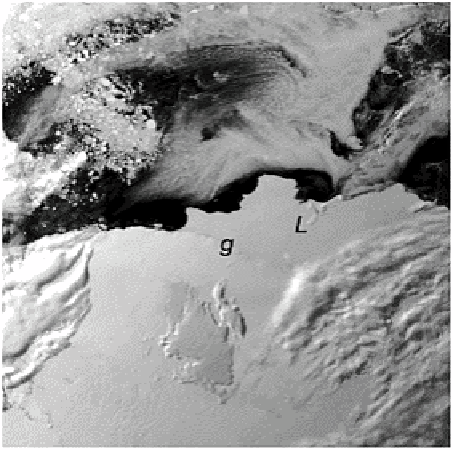Environmental Engineering Reference
In-Depth Information
Plate 15.2
The Brunt ice shelf, fed by outlet glaciers on the
east coast of the Weddell Sea, Antarctica. The change of tone
on the otherwise featureless shelf marks its grounding line
(
g
), and Lyddan Island - marked
L
- (50 km long) acts as a
pinning point.
Photo: British Antarctic Survey.
Sea ice has a superficial abrading effect on soft coastlines as it is deformed and moved by
waves and currents. It is less likely to do so where
fast ice
is literally held fast in fjords or
other enclosed locations and is more effective in the
pack ice
along open coasts.
GROUND ICE (PERMAFROST)
Annual snowpack and glacier ice can insulate their substrates from the full severity of
winter cold. In cold arid climates, where snowfall is inadequate for glacier growth, the
ground itself may be perennially frozen to great depths. Attention then shifts to the forms
and effects of ground ice. A cold wave penetrates the ground once surface temperature
falls below 0° C. What happens next depends on the porosity and thermal conductivity of
Earth materials and the behaviour of pore water, outlined first in Chapter 14.
Gravitational water freezes to form
interstitial ice
at 0° C but attractive forces lower the
freezing point below 0° C for capillary water and below −20° C for water bonded to soil
or rock particles. However, ice crystal growth exerts its own strong attractive force and
draws water to the freezing plane. Expansion on freezing generates
heaving
pressures
which displace loose soil particles. In these conditions,
segregated ice lenses
can form at
the freezing front. Its continuing downward penetration passes through the ground layer

